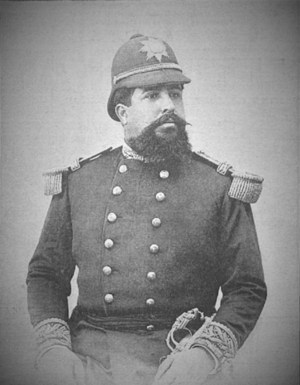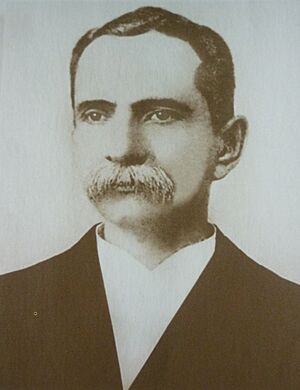Revolution of the 44 facts for kids
Quick facts for kids Revolution of the 44 |
|||||||
|---|---|---|---|---|---|---|---|
|
|||||||
| Belligerents | |||||||
| Commanders and leaders | |||||||
|
|
||||||
| Strength | |||||||
| Unknown | 5,500 | ||||||
| Casualties and losses | |||||||
|
Unknown | ||||||
The Revolution of the 44 (also called Revolución de los 44 in Spanish) was a big military uprising in El Salvador. It was led by a group of Salvadoran generals, known as "the 44". They rebelled against the government of President General Carlos Ezeta and his brother, Vice President General Antonio Ezeta.
The rebellion started in late April 1894. The rebels quickly took control of the city of Santa Ana in western El Salvador. President Ezeta then declared a state of emergency to try and stop them. By mid-June 1894, the rebels had successfully removed the Ezeta brothers from power. General Rafael Antonio Gutiérrez was then put in charge as the country's temporary president.
Contents
Why the Revolution Started
Ezeta's Rise to Power
On June 22, 1890, General Carlos Ezeta took control of El Salvador. He led a coup d'état, which is when a small group quickly takes over a government. This event overthrew and killed the previous president, General Francisco Menéndez. Menéndez himself had become president after a coup in 1885.
The government of Guatemala did not agree with Ezeta taking power. They declared war on El Salvador on June 27, 1890. Guatemalan and Salvadoran forces fought several battles. One battle happened near Coatepeque on July 21, 1890, which Guatemala won. Another battle near Tempisque on August 3, 1890, was won by El Salvador.
A New Election
The war ended in September 1890. One of the conditions was that the people of El Salvador should be allowed to choose their president. The next year, El Salvador held a presidential election. Carlos Ezeta was the only candidate. He won almost all the votes, becoming president. His brother, Antonio Ezeta, became his vice president. They started their term on March 1, 1891. Antonio Ezeta was also made the main commander of the army.
The Revolution of 1894

Rebels Take Santa Ana
On the morning of April 29, 1894, 44 rebels captured the city of Santa Ana. These rebels had come from Guatemala, where they had been living in exile. They took over the army barracks in the city. Antonio Ezeta and General Jacinto Colocho, the barracks commander, had to escape to Coatepeque.
About 500 rebels were involved in this uprising. They also had support from 5,000 soldiers from Guatemala and Honduras. Because of this rebellion, Carlos Ezeta declared a state of emergency for 29 days. This allowed the government to take special actions to deal with the crisis.
New Leadership and Battles
On May 1, General Rafael Antonio Gutiérrez, one of the rebel leaders, was announced as the new president. This was in opposition to the Ezeta brothers' government. On May 3, Antonio Ezeta was hurt by rebel forces. General León Bolaños took over as the army's commander-in-chief.
On May 5, Carlos Ezeta was traveling to Santa Ana by train with 1,000 soldiers. Rebels had removed parts of the train track on a bridge near La Ceiba. This caused the train to crash. Carlos Ezeta survived because his train car was specially built to be very strong. We don't know how many people were hurt in the crash.
The rebels also captured the Santa Ana Volcano on May 8. Government forces, led by General Joaquín López, defeated rebel forces in Chalchuapa on May 11. This forced the rebels to go back to Santa Ana. Antonio Ezeta returned as commander-in-chief on May 23 after he got better from his injuries.
Ezeta Brothers Flee
As the rebels moved closer to San Salvador, Carlos Ezeta left the country. He fled to Panama on June 4 from the port of La Libertad. From there, he went to New York City and then to Europe.
After his brother left, Antonio Ezeta became the acting president. He ordered his army to retreat to Santa Tecla on June 5. His army, which started with 1,700 soldiers, was now much smaller. Many soldiers had been killed, wounded, or had left the army.
The United States sent a ship, the USS Bennington, to La Libertad. It was there to protect American citizens in El Salvador. Antonio Ezeta and 16 other generals asked for safety on the ship. After both Ezeta brothers had left, Gutiérrez marched into San Salvador on June 10. He officially became the temporary president. The new government asked the U.S. to send back those who had fled, but the U.S. government said no. The U.S. did not officially recognize Gutiérrez as president until August 3.
What Happened Next
Gutiérrez's Presidency
Gutiérrez served as a temporary president. He was then elected president in a presidential election in January 1895. He was the only candidate and won almost all the votes. He officially started his term on March 1, 1895. Prudencio Alfaro was elected as his vice president.
Gutiérrez remained president until November 13, 1898. He was then overthrown by General Tomás Regalado Romero. Regalado became the temporary president and later made his rule official through the 1899 presidential election.
The "Heroic City"
After the revolution, the leaders who took power called the city of Santa Ana "The Heroic City." This was because of its important role in the rebellion.
In an interview in July 1894, Carlos Ezeta said he would not try to get back power. He said that the revolution was planned by Salvadorans who were living outside the country and was won with help from Guatemala. His wife, four children, and three servants joined him in exile. He was accused of taking a lot of money with him to the United States, but he said he wished that were true.
Salvadoran writer Roque Dalton wrote about the revolution in his 1972 book Miguel Mármol. He said that even with its problems, the Ezeta government was more for the people. He felt that the government of "the 44" was not as good for the country, especially because of an economic slowdown during Gutiérrez's time as president.
See also
 In Spanish: Revolución de los 44 para niños
In Spanish: Revolución de los 44 para niños
- List of Salvadoran coups d'état


